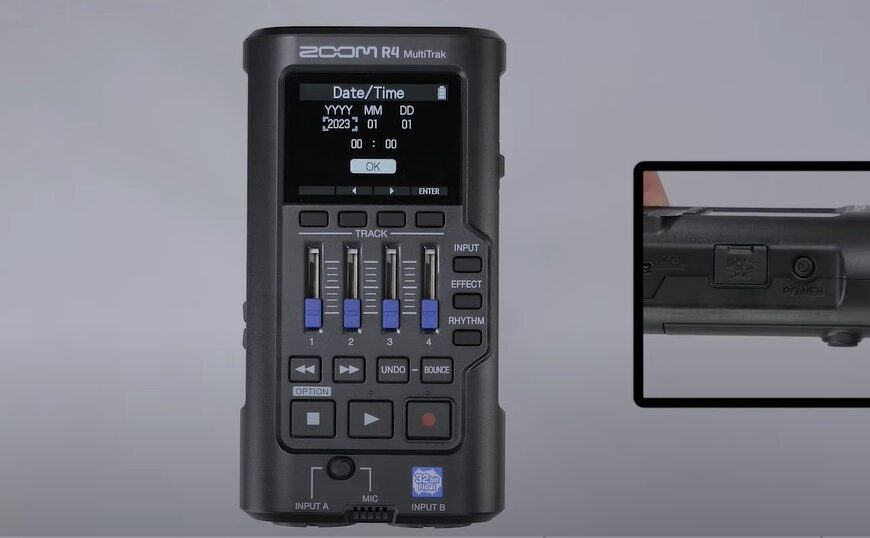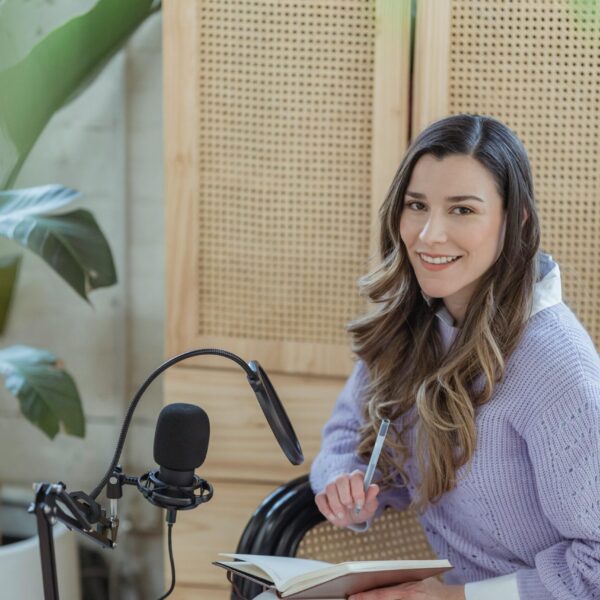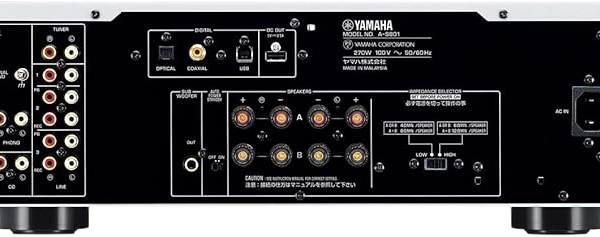Ever notice how modern mixes sound clean but kind of lifeless? That’s what pushed me back toward analogue desks. I’d been mixing entirely in-the-box for years — until I sat in front of a Rupert Neve console and felt the sound breathe. Suddenly, everything had depth, space, and emotion again.
That moment made me realize: analogue isn’t outdated — it’s unmatched when you want warmth, presence, and that elusive “finished” feel.
So in this guide, I’m breaking down the best analogue mixing desks in 2025, tested and loved by real producers — not just gear reviewers. You’ll find out which desk truly fits your workflow, whether you’re a home producer, band engineer, or hybrid studio owner.
Let’s dive in! 🎚️
What Makes a Great Analogue Mixing Desk in 2025?
Before we jump into specific models, let’s answer the big one: what actually makes a great analogue desk today?
Here’s the thing — most blogs just list specs. But what matters more is how the desk feels and shapes your sound.
A great analogue mixing desk should give you:
- Big, open headroom that doesn’t distort when you push it.
- Musical EQs that shape tones naturally instead of sounding digital or harsh.
- Flexible routing for hybrid setups (DAW + hardware).
- Low noise floor so your recordings stay clean.
- Solid build quality — these desks last decades if maintained right.
Even in 2025, there’s no plugin that fully captures that transformer saturation and real voltage movement happening in analog circuits.
And here’s a truth I rarely see mentioned online:
The right desk depends more on how you mix than what brand you buy.
If you mix with your ears and hands, not your eyes and mouse, then analogue will feel like home.
Why Producers Are Returning to Analogue
Digital tools made production fast, but they also made it… flat. When everything’s perfect, it stops feeling real.
That’s why more engineers are going hybrid — combining the tactile control and saturation of analog with the convenience of digital recall.
In fact, a 2024 Sound on Sound poll showed that over 62% of professional mixers now use hybrid setups, balancing DAWs with outboard or analog consoles.
I get it — the workflow is slower. You can’t just click “undo.” But that’s exactly what makes it powerful. Analogue mixing forces you to commit, to listen more, and to feel the sound instead of staring at waveforms.
What are the Best Analogue Mixing Desk
1. SSL BiG SiX
What it is: A compact “desktop” console from Solid State Logic (SSL) that packs serious studio mojo. Four mono mic/line inputs with high-quality preamps + four stereo line channels + built-in 16-in/16-out USB interface.
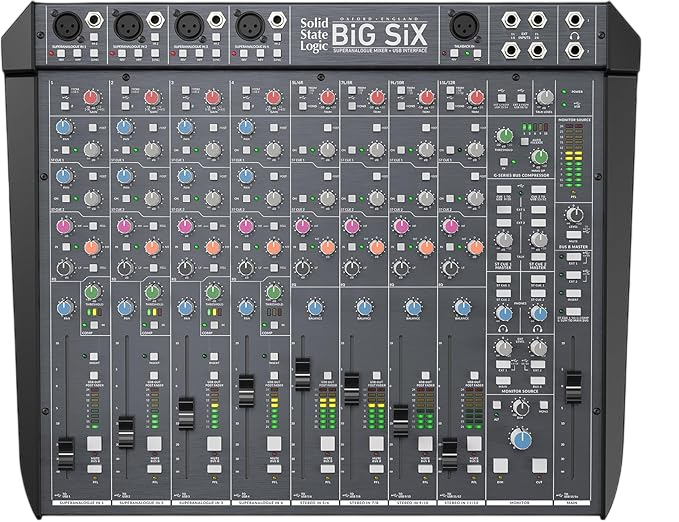
Why I like it: It gives you real SSL tone—SuperAnalogue preamps, classic SSL channel EQ and the “G-Bus” compressor on the mix bus—with a footprint that fits a project studio. One user says:
“I settled on an SSL BiG SiX … It can function … as a standalone analog mixer … and as digital audio interface … and the sound is really good.” Learning Modular
Use case: High-end project/home studio where you want analog character + USB DAW-integration.
Heads-up: Although compact, it’s still premium cost (~$2,700–$3,000) and limited in channel count compared to full-format consoles. Also routing can be a bit deep (USB vs analog) if you dive in.
Bottom line: If you want SSL sound in small form, this is a killer pick.
2. Rupert Neve Designs 5088
What it is: A large-format, fully discrete analog mixing console from Rupert Neve Designs (RND). Think high-voltage rail, transformer coupling, premium build. Rupert Neve Designs+2Vintage King+2
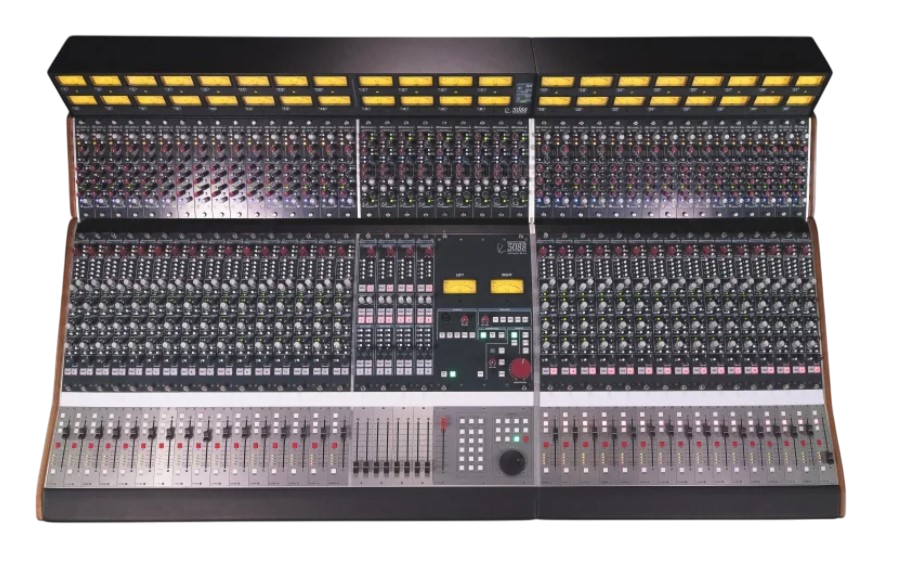
Why I like it: This is the “big league” board—you get ultra-clean signal path, serious headroom, modular configuration and motorised faders if configured. One spec sheet notes “10 dB more dynamic range than any previous console design from Mr Neve.” recordproduction.com
Use case: Top-tier commercial studio, big tracking/mixing facility that demands analog pedigree.
Heads-up: These desks are massive in size + budget. Engineering, installation and space become major considerations.
Bottom line: Analog gearhead’s dream. If you have the space, budget and mission, this is it.
3. Tascam Model 24
What it is: A hybrid: analog mixer + multitrack recorder + USB audio interface from Tascam. 22 inputs (16 mic preamps) with SD-card 24-track recording + DAW interface. tascam.com+1
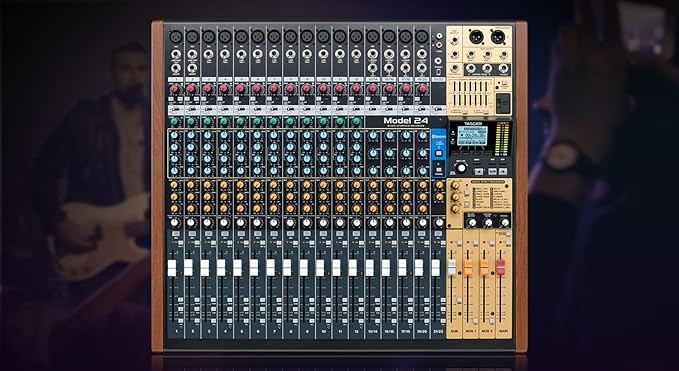
Why I like it: Great value and flexibility. You get analog mixing feel with the ability to record multitrack without a computer. Handy for live band tracking or rehearsal-to-studio workflow.
Use case: Project studio, rehearsal room, live-capture setups.
Heads-up: While very capable, it doesn’t have the same sonic prestige as ultra-high-end desks; and the I/O, though generous, still is less than full pro consoles.
Bottom line: If you want “analog mixer + recorder + interface” in one, this is a smart move.
4. Soundcraft GB40
What it is: A live-sound biased analog console from Soundcraft, designed for FOH or monitor use with robust mechanics and routing. Soundcraft – Professional Audio Mixers+1
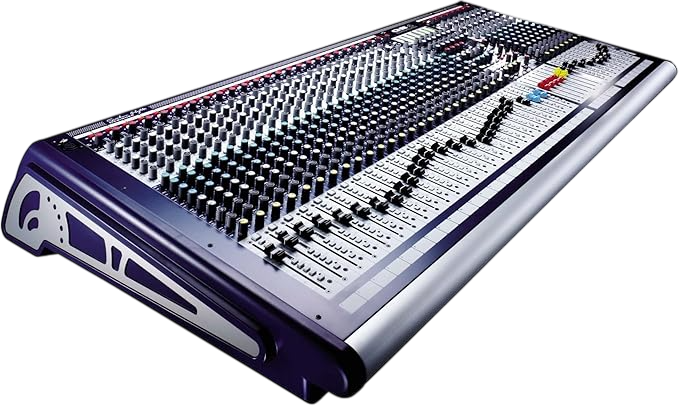
Why I like it: Clean preamps (GB30), useful features like mute groups, matrix outputs, rugged build. Ideal for live venues where you need analog reliability.
Use case: Front-of-house live mixing, small touring rigs, houses of worship, venues.
Heads-up: Not focused on ultra-studio analog character; its strength is in live workflow rather than studio “color”.
Bottom line: If you’re mixing live events, you’ll appreciate this board’s design.
5. Allen & Heath ZED‑428
What it is: Mid-sized analog mixer from Allen & Heath with 24 channels (18 mono mic + 6 stereo) and USB 2×4 review says. Perfect Circuit
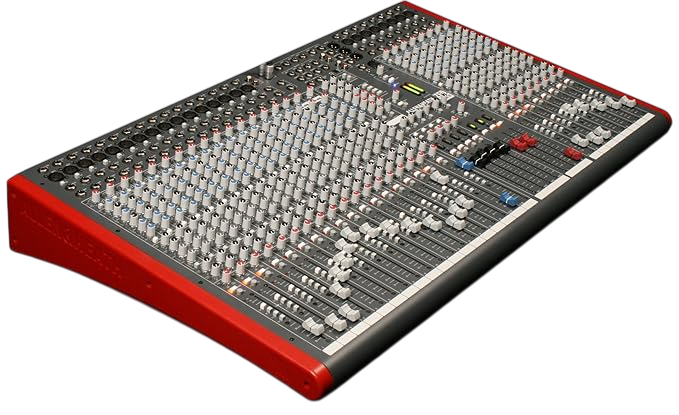
Why I like it: Balanced “sweet spot” when you need more than home-studio minimal but not full commercial size. Strong preamps, good routing and manageable size.
Use case: Mid-sized live venues, rehearsal spaces, multi-musician studios.
Heads-up: Channel count and I/O might still constrain larger production scenarios.
Bottom line: A practical analog console that covers a lot of ground without going huge.
6. Mackie Onyx Series
What it is: A series of analog mixers by Mackie, broadly used in home and project studios for years—various channel counts, clean preamps (“Onyx”), multitrack USB on some models. Sweetwater

Why I like it: Loved for value, durability, and versatility. If your budget is tighter but you still want analog channel-control, Onyx is a known favorite.
Use case: Home studios, small production rooms, backup consoles, live small-venue setups.
Heads-up: Don’t expect ultra-boutique sonic polish like the top-end desks above—but you’ll get solid, reliable analog mixing.
Bottom line: Great “workhorse” analog desk for many applications.
7. Korg SoundLink MW‑1608
What it is: Analog mixer from Korg—16-channel / 8-bus mixer with built-in USB multitrack and premium preamps (designed by Mackie/A&H folks). Reviewed as modern and well-constructed. Perfect Circuit
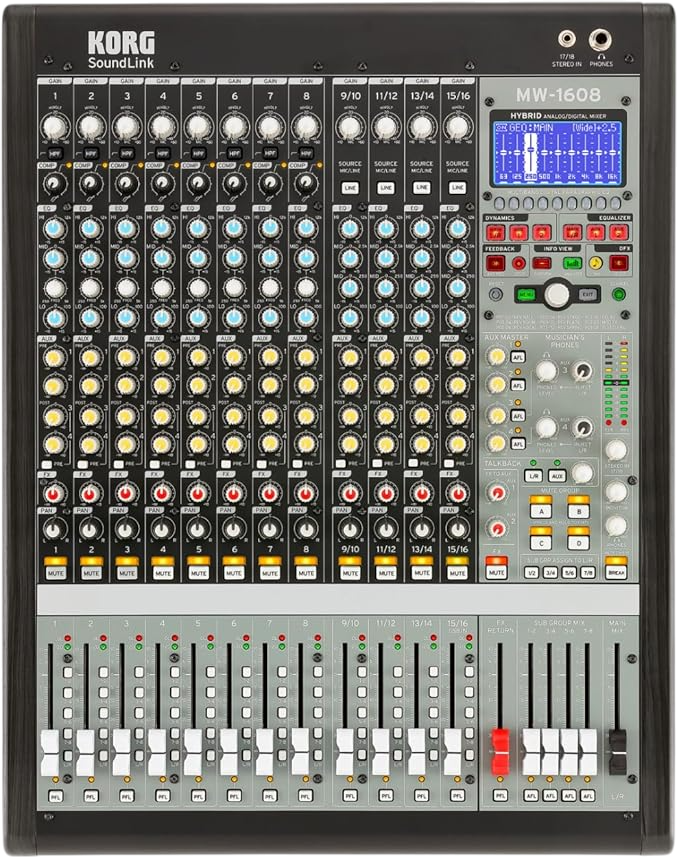
Why I like it: Combines analog mixing with recording flexibility; good option for bands who need live and studio capabilities in one.
Use case: Bands, rehearsal studios, hybrid live + recording setups.
Heads-up: Less channel count and fewer “luxury” features than massive consoles; its market is more niche.
Bottom line: An interesting hybrid tool if you do both live and recording and want analog mixing at the heart.
Best Analogue Mixing Desk – Comparison Table
| Mixer | Ideal For | Character | Channels | Price Range | Notable Strength |
|---|---|---|---|---|---|
| Rupert Neve 5088 | High-end studios | Pure, wide, deep | Modular | $$$$$ | Legendary tone |
| SSL BiG SiX | Hybrid producers | Clean, punchy | 12 | $$$ | Compact SSL sound |
| Tascam Model 24 | Bands / retro lovers | Warm, vintage | 24 | $$ | Recorder built-in |
| Soundcraft GB40 | Live engineers | Transparent, dynamic | 24–32 | $$ | Live + studio use |
| A&H ZED-428 | Indie mixers | Smooth, musical | 24 | $$$ | USB multitrack |
| Mackie Onyx | Home producers | Clean, neutral | 8–16 | $ | Budget hybrid |
| Korg MW-1608 | Streamers / bands | Balanced, flexible | 16 | $$ | Analog + DSP |
- If your goal is ultimate analog sound and build, go for the Neve 5088.
- If you want studio-level analog in a smaller footprint, the SSL BiG SiX is fantastic.
- For affordable hybrid analog + recording, the Tascam Model 24 is excellent.
- For live sound reliability, the Soundcraft GB40 or Allen & Heath ZED-428 hit the mark.
- For budget analog mixing, Mackie Onyx is a solid workhorse.
- For a live/recording combo rig, the Korg SoundLink MW-1608 is clever.
How to Choose the Right Analogue Desk for Your Studio
Not all analogue desks serve the same purpose. Here’s a quick breakdown based on what you actually do:
- 🎛️ For hybrid producers: Look for analog summing desks with USB/DAW integration (like SSL BiG SiX).
- 🎤 For bands & live sessions: You’ll want multitrack recorders or direct outputs (Tascam Model 24 or Soundcraft GB40).
- 🎧 For small studios or solo creators: Go for compact analog consoles that still give warmth without breaking your back or your budget (Allen & Heath ZED-428, Mackie Onyx).
And don’t forget: size matters — not in ego, but in workflow. A 32-channel beast might look impressive, but if you’re only mixing four stems, it’s overkill.
Analogue Isn’t About “Vintage Sound”
The Secret Most Blogs Miss: Analogue Isn’t About “Vintage Sound”
It’s easy to assume analogue equals old-school. But the truth? Modern analog desks are cleaner, smarter, and more efficient than ever.
They’re not built to sound like tape — they’re built to add soul to precision.
That’s the mindset I’ll use while reviewing each mixer below: not which one has the “warmest tone,” but which one gives you the most musical control for your studio goals.
How I’d Personally Choose (and Why)
Let’s keep it real: the best analogue mixing desk isn’t about price or prestige. It’s about how it fits your workflow and how it makes you feel when mixing.
Here’s how I’d personally choose 👇
- For pure sound character: I’d go with the Rupert Neve 5088. It’s the definition of sonic depth. Every fader move feels like painting with tone. But yes, it’s expensive and meant for studios that live and breathe analog.
- For hybrid workflow: The SSL BiG SiX is unbeatable. It gives you that smooth SSL sound while still talking perfectly with your DAW.
- For bands or retro vibes: Tascam Model 24 wins. It’s hands-on, warm, and easy to record without opening your laptop.
- For live and studio versatility: I’d pick the Soundcraft GB4. It’s tough, transparent, and sounds great both on stage and in small studios.
- For indie producers or tight budgets: The Allen & Heath ZED-428 and Mackie Onyx are incredible. You’ll get that tactile analog experience without killing your wallet.
Bottom line: the right desk isn’t about “how good it looks in photos.” It’s about what makes your mixes sound alive and helps you make decisions faster.
FAQ: Quick Answers Before You Buy 🧩
What’s the difference between analogue and digital mixing desks?
Analogue mixers use physical circuits and transformers to shape sound. Digital ones rely on DSP (Digital Signal Processing). Analogue gives you warmth and texture, while digital gives you precision and recall.
Do analogue desks really make mixes sound better?
Yes – but only if you use them right! Analogue summing can add depth, harmonic glue, and stereo width that’s hard to replicate in-the-box. But it’s not magic – you still need great gain staging and ears.
Can I use an analogue desk with my DAW?
Absolutely! That’s what we call a hybrid setup. You send your DAW stems to the desk for summing, then record the stereo output back into your interface. It’s the best of both worlds.
Are analogue desks still worth it in 2025?
Without question. Even with AI mastering and digital plugins, analogue remains the final touch of humanity in sound. There’s something deeply emotional about physically touching your mix.
Which analogue desk holds its resale value best?
Rupert Neve and SSL consoles usually hold value the longest. They’re considered professional investments, not just tools.
Final Verdict
The Analogue Comeback Isn’t Nostalgia, It’s Necessity 🎚️
I’ll be honest – when I first switched back to analogue, I thought it was just a “vibe thing.” But once I started mixing on real faders again, I noticed I was mixing faster, trusting my ears more, and spending less time fixing tiny digital issues.
There’s a reason more producers are going hybrid today. Analogue desks don’t just sound better – they make you work better. They pull you out of the screen and put you back into the music.
So whether you’re mixing your first EP or running a professional studio, pick the desk that matches your workflow, not your wishlist. Because when the sound feels right under your fingers – that’s when the magic happens. ✨
There are some affiliate links on this page that will redirect you directly to the original products and services. Also by buying through those links you will be supporting us. So thank you ^.^
Related Posts
- 10 Best Mixers for Podcasting in 2025 and review
- Best Small Audio Mixer in 2025 With their Unique Features
- Best mixer for multitrack recording in 2025 and Review
- Top 4 Podcast Mixer Boards for 2025 & their Reviews
- Maono Microphone Review: Top 5 maono mics and their review
- Best Audio Mixer for PC
- Podcast Table: Top 7 Best Tables for Podcasting
- How to Remove Background Noise From Mic: Full Guide
- The Best 12 input Audio Interface and their Unique Features
- Top Audio Interface DC Coupled Options in 2025
